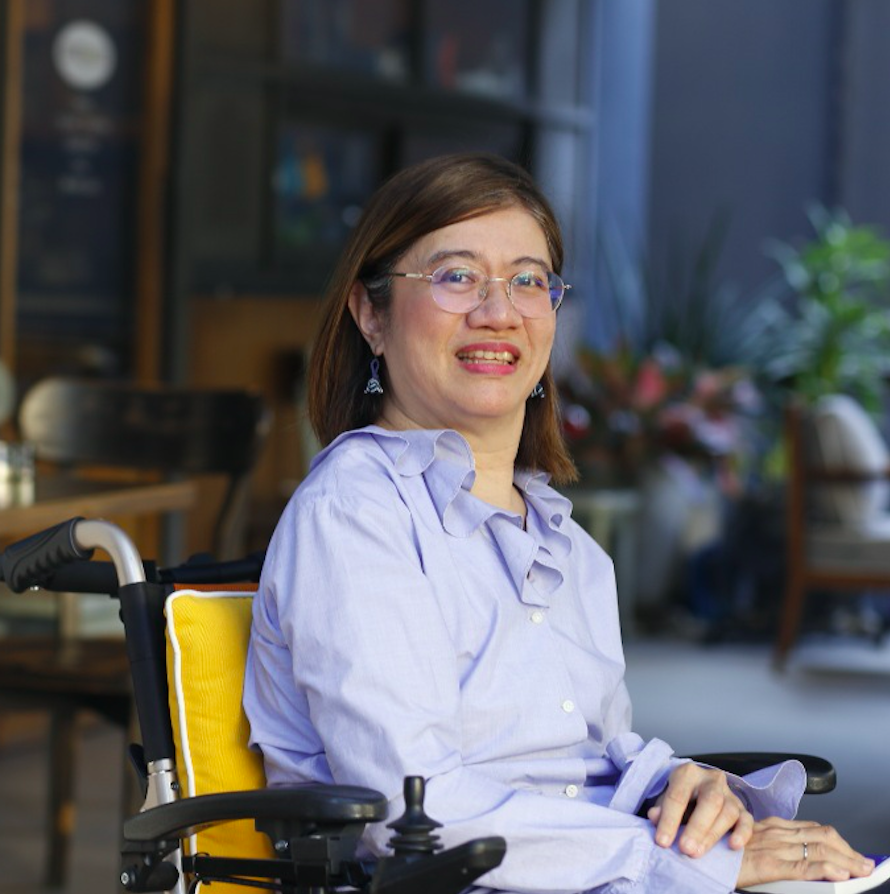Jane Ngarmpun Vejjajiva is tired of being pitied. The distinguished Thai writer has numerous accolades to her name — including a S.E.A Writer Award in 2006 for her debut novel — but more often than not, Vejjajiva is reduced to her identity as a wheelchair user.
“I find it annoying,” she says candidly. “We put labels on disabilities instead of on talents. There’s this idea of condescension, of being superior, that people tend to have vis-à-vis artists with disabilities — ‘we have to buy their works because they are blind’.
“People with disabilities want to be treated as they deserve. And I prefer to be judged by the quality of my works, not my conditions.”
Vejjajiva is not alone. It’s a familiar pain point to the Thai writer and other creatives who happen to have disabilities: their works are often reduced to that of a piece done by “a disabled writer”, regardless of its other merits.
That’s just one issue that Vejjajiva spoke about at Vis a Visibility, a programme held at the 2020 edition of the Singapore Writers Festival. Moderated by Singaporean author Cassandra Chiu and helmed by several other panelists — including Filipino poet Ramón C Sunico and Indonesian creative Khairani Barokka — Vis a Visibility explores the challenges that people with disabilities face in Southeast Asian literature, both in the real world and on the page.
But the struggle for creatives with disabilities doesn’t just end at the publishing house: as Vejjajiva explains, while writers have to deal with sympathetic “discrimination” from the well-meaning, their fictional counterparts have their own battles to fight.
“I’m afraid I haven’t seen many changes in portraying persons with disabilities in literature in Thailand,” says Vejjajiva. “Being disabled has a spectrum of conditions — mild or severe, visible or invisible — but characters in these literary works tend to be flat, one-sided or, in some cases, overdone.”
Well-written characters who exist beyond their disabilities, or who present a realistic and nuanced view on persons with disabilities, are rare in popular literature.
For all the saccharine charm of Tom Hank’s titular character in the hit book-turned-movie Forrest Gump, it’s arguable that the intellectually disabled man is only universally beloved because he’s so incredulously talented (let us not forget that in his lifetime, the character was a war hero, world ping pong champ and savvy businessman) — to say nothing of the character’s inoffensive straight-white-man archetype. That sets a disturbing precedent for people with disabilities: people might love you, but only if you’re wildly talented, successful and/or you fit a certain rigid profile.
As Michael Auberger, the late co-founder of Denver-based disability rights group ADAPT, once said: “Able-bodied people have a way within the media and movies of creating us either as superheroes or pathetic objects… There’s very little in between. You can’t just be an average Joe… You’ve got to be a hero. And you’re not.”
Al Pacino’s visually handicapped (and libidinous) war veteran in Scent of a Woman might seem to present a more unflattering — and presumably realistic — take on people with disabilities, but the accolade-laden movie also came with issues of its own.
While Pacino is presented to audiences as a hot-blooded man still capable of driving a Ferrari, beating up a man, and dancing the tango (both literally and horizontally), he’s also shown to be a bitter, angry person, and little else — a common trope ascribed to disabled characters in popular culture. He is also ultimately “redeemed” by his bright-eyed, able-bodied companion, implying, perhaps obliquely, that people with disabilities must rely on the able-bodied as their physical and moral compass.
Conversely, there’s The Fault In Our Stars, the John Green novel lauded for putting the spotlight on an underserved population of oncological patients — more specifically, teenage patients, who often have to juggle hormones and peer approval alongside chemotherapy sessions and questions of mortality. Yet for all the praise heaped on the book, it was not without its criticism, for purportedly “romanticising” an ugly condition.
As one two-time cancer survivor bluntly puts it: “John Green took one of the crappiest experiences in my life and romanticised it for a book.” Some oncologists have even noted that the book is unrealistic and unnecessarily bleak.
One positive example? Vejjajiva has a particular fondness for The Fundamentals of Caring, a 2016 indie film based on a novel by Jonathan Evison. In the film, Paul Rudd (of Ant-Man fame) stars as the beleaguered caretaker of a cantankerous, sexually frustrated teenager with muscular dystrophy, played by Welsh actor Craig Roberts.
Roberts’ character is often abrasive and crass (while watching a voluptuous presenter on TV, his character blithely asks Rudd’s: “Would you tap that? Because I would pound that s— to the ground.”) — but he’s also shown to be an emotionally vulnerable and lonesome teenager. And while Rudd does prod him along, Roberts’ journey of self-discovery is one that’s ultimately self-directed and self-motivated.
Nuanced portrayals of regular people with disabilities are unfortunately an exception, as well as the antithesis of more common depictions of people with disabilities in mainstream media.
“Characters with disabilities should be presented under the light of truth,” says Vejjajiva. “There are cliches to be avoided — people with disabilities are human, too.”
But Vejjajiva says that things are gradually looking up. She says that the unique nature of the literary world ensures that “there are no special treatments needed to get a work published” — you just need to be talented. And with more talented authors coming into the fold, it opens up the possibility of seeing a greater range of voices and experiences in books and movies alike.
“By portraying people with disabilities in a true light, you give them room and space in society,” says Vejjajiva. “And when we’re together on an equal footing, we can move towards a brighter future.”




